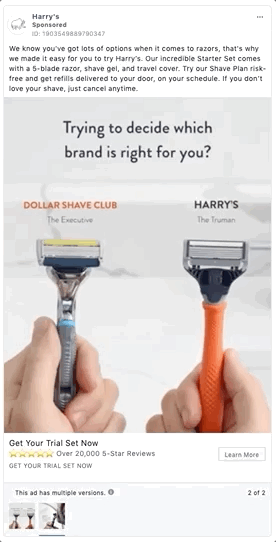It’s easy to feel lost or confused when trying to create Facebook ads from scratch, as there seemingly are so many variables that need to be taken into account when setting up your campaigns.
Arguably, the most important variable you need to consider is creative. That’s because Facebook is a predominately visual medium, where you compete for attention – not just with other advertisers, but also friends, family, and organic content publishers.
No matter how robust your targeting, the bottom line is, that without powerful creative that draws people in, you’ll struggle to generate results.
And that’s why many marketers think that Facebook doesn’t work for them. They came, they saw, they did not conquer. They threw bad creative at the platform, threw good money at it, but the results were a little…underwhelming.
Sign up to our free Google Ads email course.
7 days, 7 lessons. Everything from how to structure your Google Smart Shopping campaigns to ad testing, and YouTube ads excellence. Sign up and level up your Google Ads eCommerce game.
A benchmarking framework for Facebook ad creative
That’s why we created the Mastering Facebook Ads tool
We wanted to isolate the key themes of a successful Facebook ad, with the understanding that different verticals are likely to value slightly different things. To this end, we analysed creative trends within retail, finance, and travel, separately, as we wanted to understand what best practice looks likes across each vertical. Emergent themes were grouped together into a a final list of 12 across each vertical, which were designed to reflect key commonalities in relation to Facebook ad creative.
We chose to focus on high-growth start-ups, as the they are more likely that larger businesses to use Facebook as a primary driver of customer acquisition. There’s also natural assumption that best-in-class advertisers tend to be smaller, more agile companies, that value creativity and innovation in there approach.
Below are just a few of the themes we found to be particularly prevalent amongst the sample. Click on one of the industries below to see vertical-specific insights, or read on below for a breakdown of key takeaways.
Keep video ads under 20 seconds
Keeping video ads short and to the point is key to driving quality interactions. According to Wistia, people watch more than 80% of a video shorter than 30 seconds. Lengthy Facebook videos, on the other hand, aren’t as effective as shorter ones because people lose interest quickly as they scroll the news feed. That’s certainly reflected in the 89% of advertisers who ran videos with an average length of under 20 seconds
Birchbox show how you can deliver big impact with a short ad. The initial three seconds in particular draw the user in, and the rest of the ad builds on the core offer, with a constant call-to-action also visible.
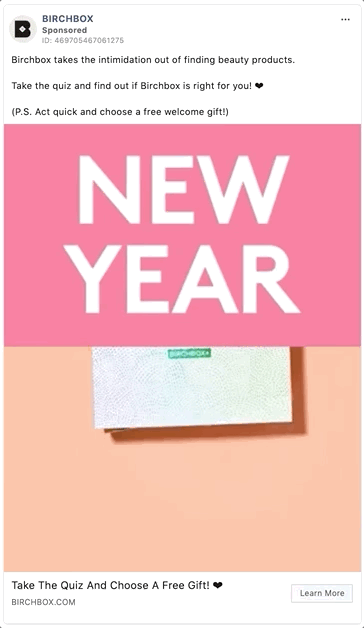
Add some social proof
Our study found that 85% of retail brands used some form of social proof within their ads. Social proof is public social engagement that other users can see. This includes likes, comments, and shares of an ad. It can also include award wins, reviews, and other forms of press engagement. These interactions can matter just as much as the ad copy when it comes to building trust and credibility. When someone is deciding whether or not to engage with an ad, or any other post for that matter on Facebook, one key consideration is if other people previously engaged with the ad before they saw it. This is the power of social proof in action.
Some form of social proof should be applied to all ads, whether it’s a number of how many have bought your product, a review rating, reference to an award win, or a press snippet. This can be included within the description of the ad, or for best results, overlaid on top of your image for maximum visibility. Be mindful that the social proof you’re using should be relevant to your target audience.
Mattress start-up Helix know that award wins can set its product apart in a crowded marketplace, and leverages these to the max, coupled with the use of emojis for added visual appeal.
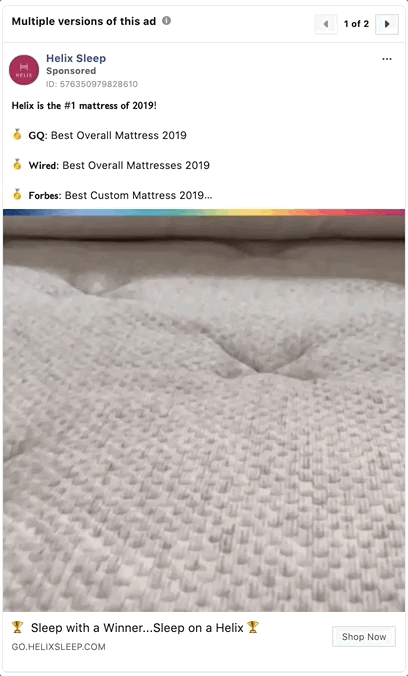
Unlock the power of themed carousels
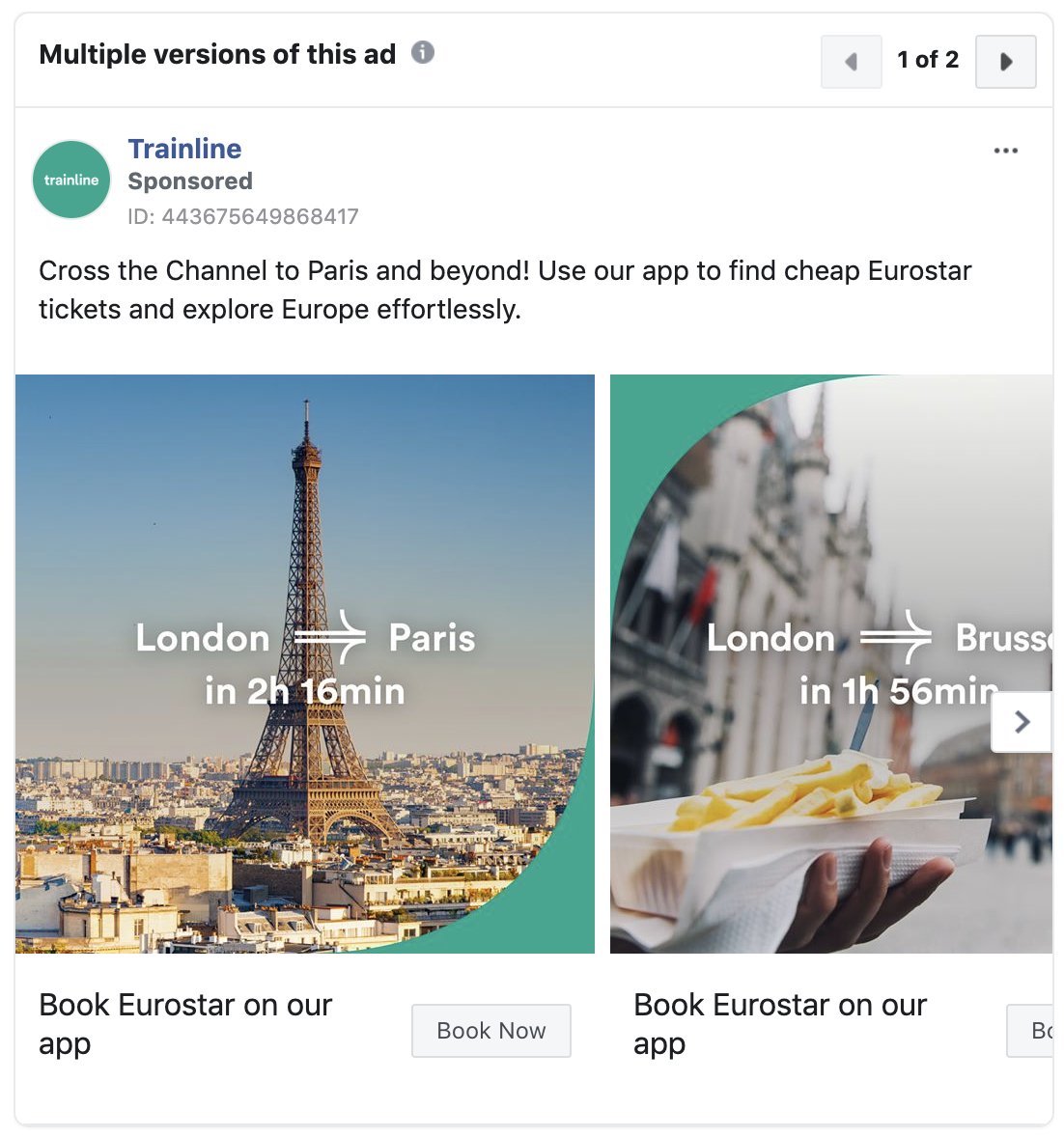
Unpack your USP
Our Mastering Facebook Ads study found that a whopping 89% of high-growth finance brands used some form of animation within their Facebook ad portfolio.
Animation can often be the most relatable way to communicate a unique selling proposition – that is, the factor or consideration presented as the reason why your product or service is different from and better than the competition. In other words, it’s what your brand stands for, and what sets it apart from others. Instead of attempting to be known for everything, brands with a clear, compelling USP stand for something specific, and it becomes what they’re known for.
For example, Lemonade insurance seek to position themselves as the insurance brand for millennials. It started by focusing on the things that matter to this group of people – a fast and efficient claims process, app-based coverage as opposed to endless paperwork, and a product in line with needs of generation rent. It’s the new kid on the block, the disruptor and the digital-first insurer that loves nothing more than to stick it to the big guys in the industry. By using short, snappy animations to drive visual impact, it does just that. The use of colour is no accident either, and this is a great way to bring attention to individual elements within the ad.
The lesson here is to take a step back from the tactical, and focus, really focus, on what makes you better than the competition, whether you choose to define that in a corporate entity or in a broken, old-school process. For added impact, use the power of juxtaposition to visually explain the value that your product or service provides, in a concise and relatable way.
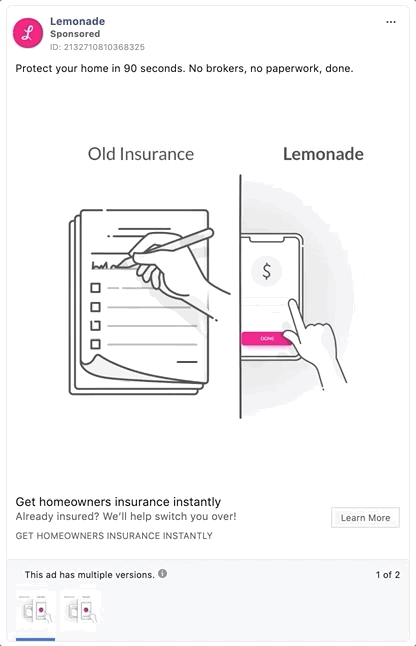
Don't just sell
Ever head the saying, content is king? With Facebook Ads, good quality content is invaluable. The bottom line is that people like to engage, they don’t like being sold to. Which probably explains why so many advertisers fail to scale their Facebook efforts – they put too much creative emphasis in being transactional, and not enough in being inspirational, and challenging commonly help perspectives.
And in being so transaction-focused with your creative, you ignore a big old chunk of your audience. At the top-of-the-funnel it should really be all about driving inspiration, prompting people to take baby steps into your universe.
No one understands this better than travel brands, with a 77% of them using inspirational and educational ads at some point within their Facebook ad portfolio. Airbnb for example, try to inspire their audience to broaden their horizons, by showcasing a bucket list of possible destinations to align with the start of a new decade.
The best Facebook advertisers don’t act like advertisers, not in the traditional sense anyway. They understand that sales-based messages seldom cut-through without first investing time and effort in cultivating your audience. Inspirational content should be at the very forefront of the top of funnel for brands. Be a resource, not just another advertiser.
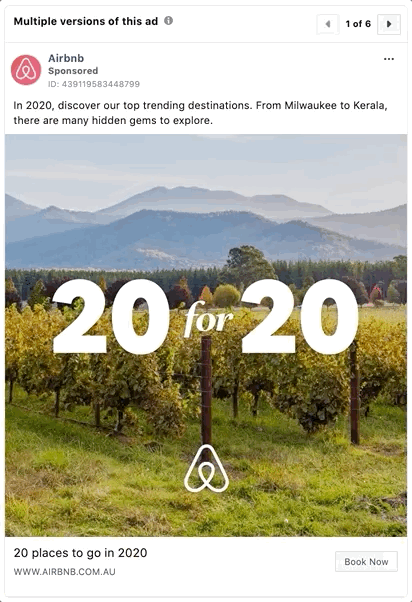
Amplify your happy customers
Happy customers seldom become advocates, but when they do, it can be a beautiful thing. Social media is often the first port of call for consumers, when looking to share both their positive and negative buying experiences with friends and family.
For example, 76% of finance brands analysed ran ads that had at least one social proof signal. Cuvva, a UK-based car insurance start-up, take this a step further – doubling-down on social proof, with a user generated quote accompanied by a prominent TrustPilot review rating.
Forward-thinking brands can leverage these interactions in a number of ways. Very simply, all ad creative should contain at least one element of social proof: testimonials, reviews and ratings, influencer endorsements, trust badges – they all count as social proof signals. These signals can be included within the description of the ad, or for best results overlaid on top of your image for maximum visibility.
Be also mindful that the social proof you’re using should be relevant to your target audience, and always be looking to test multiple forms of social proof against one another, in order to build your ads effectiveness over time.
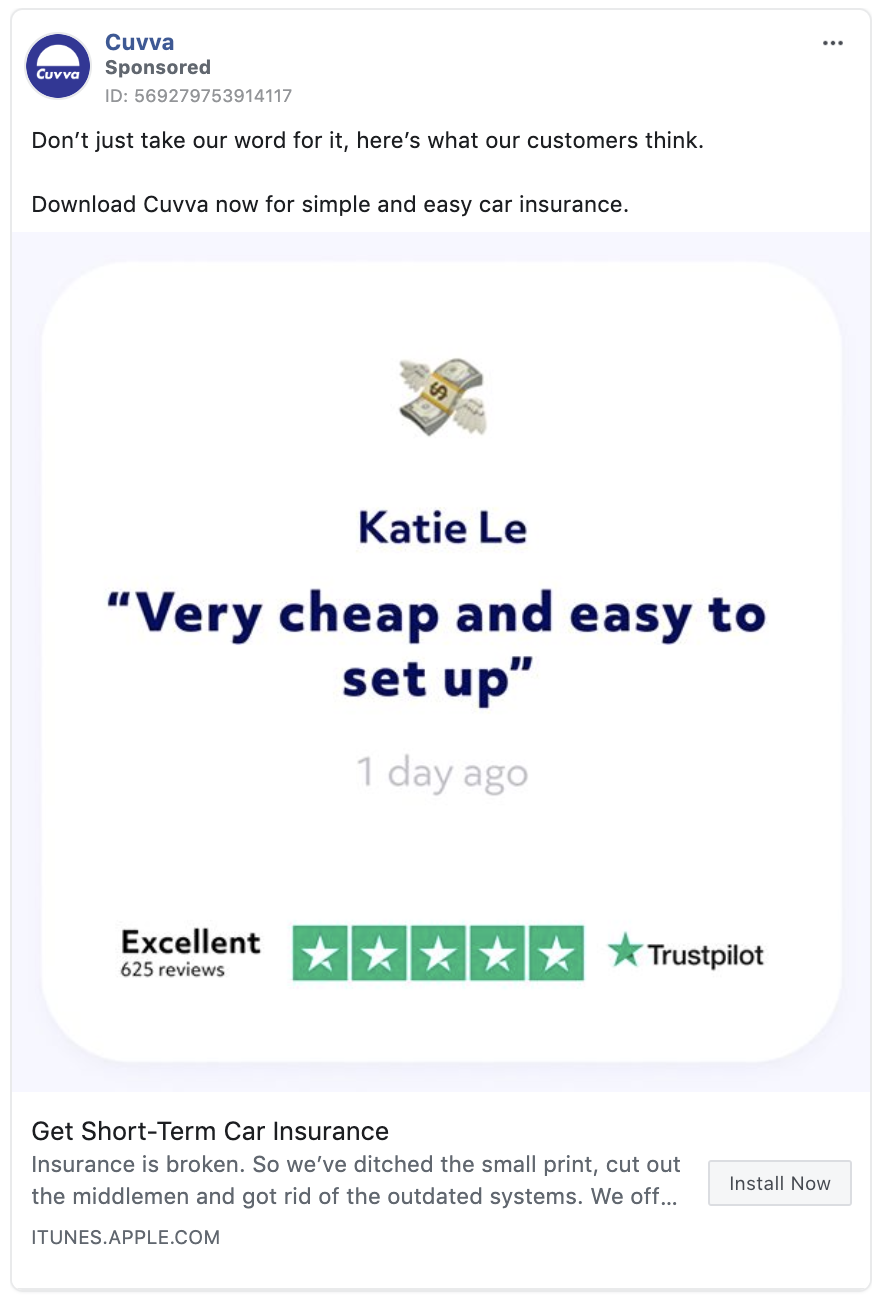
Make your ad not look like an ad
Gamification is a great way to increase top of funnel visibility, as it encourages people to share your content within their social circles. In doing so, you can expect to drive incremental traffic, and there’s also the opportunity to retarget ad engagers with more product-led messaging down the line. Our study found that this tactic was particularly popular in the finance and travel verticals, with 68% of former and 63% of latter adopting it within their campaigns.
Middle Eastern online travel specialist HolidayMe created a travel calculator which encouraged participants to score themselves based on their 2019 holidays. Cleverly, this also allowed them to retarget people with specific messaging, based on their individual scores.
When it comes to gamifying your ad content, there are many different ways you could add a viral touch, so test and learn to find the right approach for your audience.
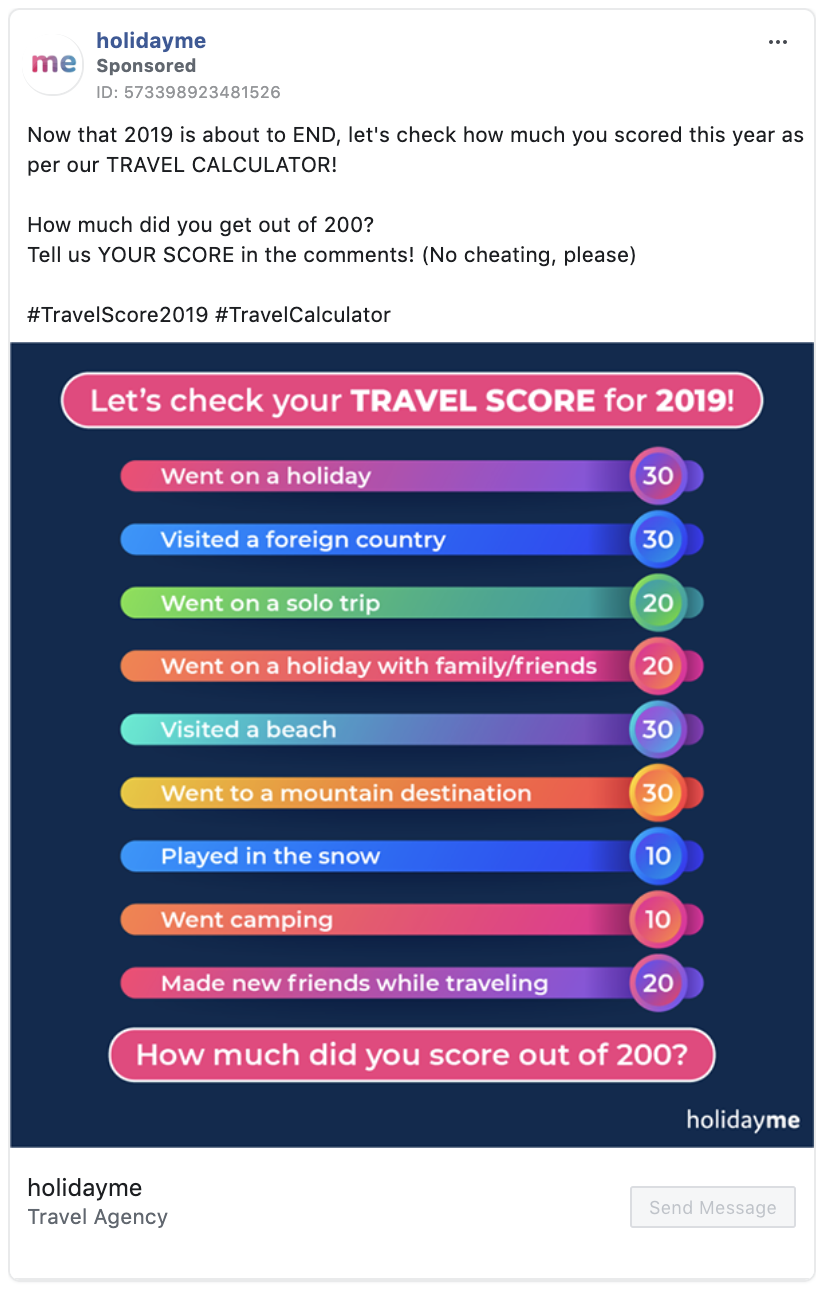
Go head-to-head with your competitors
Sometimes, the direct route is the best option.
And when you’re a challenger brand in a competitive space, this approach makes even more sense.
That’s why 57% of fast-growth retail businesses choose to go head-to-head with established competitors within their ad creative.
For example, shaving brand Harry’s provide a masterclass in competitive creative, with an entire campaign aimed at one of their main rivals, Dollar Shave Club. Not only do Harry’s offer several brand-specific reasons to choose their products, they also use video and social proof to enhance their message.
Throwing up a target can be an effective way to contextualise your message. A direct competitor comparison ad gives your audience a clear understanding of why your brand is best positioned to meet their needs. Tread carefully, as this are can risk retaliation, or in extreme examples even litigation. That’s why it’s best to stick to objective facts where possible, or even better, user generated content in the shape of customer social media posts where your brand comes off favourably.
